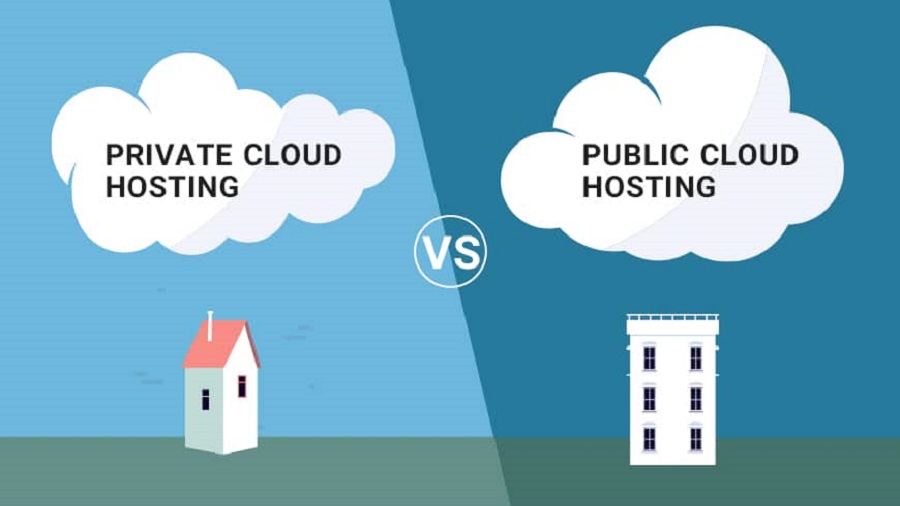The Difference Between Public Cloud And Private Cloud And Hybrid Cloud, Which One Is Better?
The Term Cloud Computing Includes A Range Of Classifications, Types, And Architectural Models. This Grid Computing Model Has Changed The Way We Work.
But the cloud is not only a theoretical and straightforward issue; to better understand this technology, we have also given you complete explanations in this article.
Also, the difference between public and private cloud is mentioned in this article so that you can easily choose and make the best use of cloud services.
Cloud computing can be classified into three general types:
- A public cloud is cloud computing provided over the Internet and shared among organizations.
- A private cloud is cloud computing dedicated solely to your organization.
- A hybrid cloud is an environment that uses public and private clouds.
In the following, we will explain each one in detail and help you understand the differences between public and private cloud services and find exemplary service for your business.
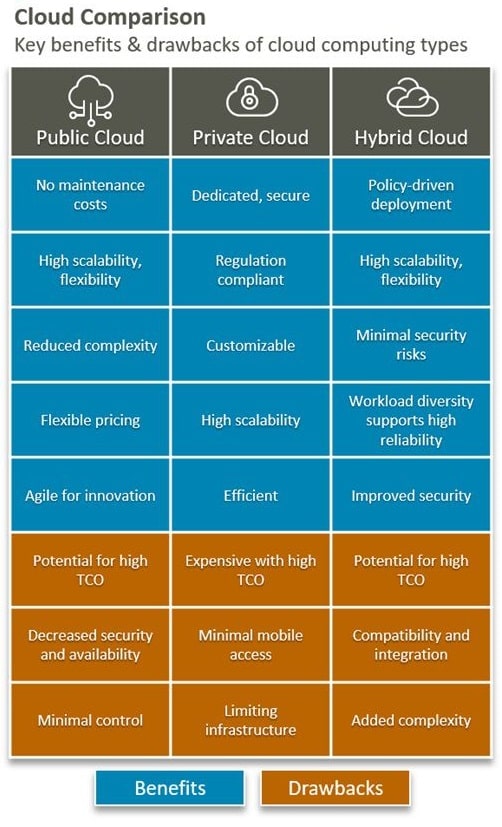
What is cloud computing?
Cloud computing processes or stores your programs, applications, and data over the Internet instead of directly on your computer’s hard drive. The most famous examples of cloud computing are Software as a Service (SaaS), Platform as a Service (PaaS), and Infrastructure as a Service (IaaS) – most of which you can choose to set up on a public or private platform. Cloud computing provides more services, including:
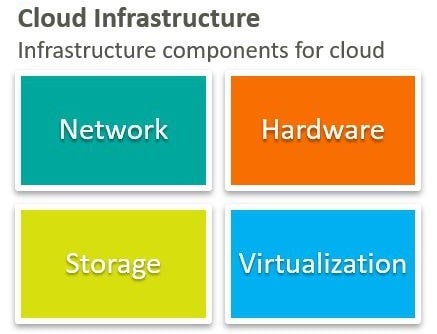
- AIaaS: Artificial Intelligence as a Service
- DaaS: Desktop as a Service
- ITaaS: Information Technology as a Service
- RaaS: Ransomware as a Service
Any cloud service consists of client-side systems or devices (PCs, tablets, etc.) connected to back-end data center components (servers). The elements that make up the cloud infrastructure are:
Basic infrastructure architecture can have various forms and features, including:
- Virtualized
- Software-defined
- Hyper-converged
Individuals and companies alike enjoy the distinct benefits of cloud computing, including:
- Reduce complexity
- DevOps optimization
- CapEx and OpEx exchanges
- Planning for the future
Examples and use cases of cloud computing
There are clear examples of cloud computing as well as use cases of public and private cloud differences that many of you may use in your personal or professional life:
- File sharing platforms, such as Dropbox, Google Docs, and Microsoft 365
- Social networks and telecommunication services such as Facebook, Twitter, and Skype
- CRMs and productivity management tools such as Salesforce and Atlassian
- ITSM and ITOM software such as BMC Helix
- Online streaming services such as Netflix, Sling, and Hulu
- Machine learning and extensive data analysis
- Internet of Things
What is a public cloud?
The public cloud refers to a cloud computing model in which IT services are provided over the Internet. As the most popular cloud computing service model known, the public cloud offers a wide selection of computing solutions and resources to meet the ever-increasing needs of organizations of all sizes.
The defining characteristics of a public cloud platform are:
- High flexibility and scalability
- Reasonable prices for plans
Public cloud services can be much cheaper than other services where you are charged based on the computing resources consumed.
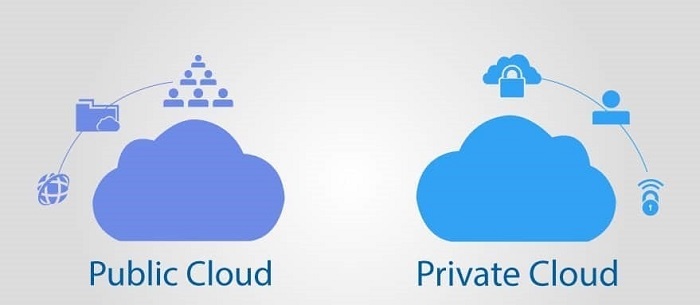
Computing performance may range from standard services—email, applications, and file storage—to enterprise-level operating system platforms or infrastructure environments used for software development and testing, each of which has its differences and can be Public or private clouds provided.
A company that provides cloud services, whether public or private, is responsible for developing, managing, and maintaining a pool of computing resources shared among users across the network.
When to use the public cloud?
The public cloud is more suitable for these types of environments:
- Predictable computing needs, such as communication services for a certain number of users
- Programs and services necessary to carry out information technology and business operations
- Additional required resources to address various basic and urgent needs
- Software development and test environments
Benefits of public cloud
Some of the benefits of the public cloud are:
- No need for CapEx. There is no need to invest in IT infrastructure deployment and maintenance
- Technical agility. High scalability and flexibility to meet the requirements in an unpredictable work environment
- Business focus. Complexity is reduced, and requirements for IT expertise are minimized because the cloud service provider is responsible for managing the infrastructure.
- Increase financial power. Pricing options are flexible
- The cost agility of this service allows organizations to follow growth strategies and focus their investments on innovative projects.
Disadvantages of public cloud
The public cloud comes with limitations:
- Uncontrollable service total cost of ownership (TCO) can increase exponentially for large-scale deployments, especially for medium to large enterprises.
- The lack of security of the public cloud is inherently the least secure, so it’s not the best choice for mission-critical IT workloads.
- Minimal technical control and low infrastructure control may not meet your needs.
What is a private cloud?
Private cloud refers to any cloud solution that is dedicated for use by an organization. In the private cloud, unlike the public cloud, you don’t share cloud computing resources with any other organization, and this is the main difference.
Data center resources may be located at your location or operated by a third-party company overseas. Computing resources are isolated, delivered to you over a secure private network, and not shared with other customers.
A private cloud can customize to meet an organization’s unique business and security needs. With greater visibility and control over the infrastructure, organizations can run mission-critical computing without compromising the security and performance previously only available with dedicated on-premises data centers.
When to use a private cloud?
A private cloud is suitable for:
- Industries and government organizations with high supervision
- Sensitive data
- Companies that need firm control and security over their IT workloads and infrastructure
- Large companies that need advanced data center technologies for practical and cost-effective operation
- Organizations that can invest in high-performance and accessible technologies
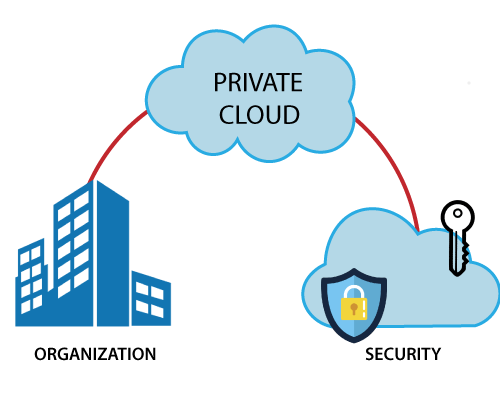
Advantages of private cloud
The most popular differences and advantages of a private cloud over a public cloud are:
- Exclusive environments are private and secure environments that are not accessible to other organizations.
- Customized security Comply with strict regulations because organizations can implement protocols, configurations, and actions to customize security based on their unique business requirements.
- High scalability and performance to meet unpredictable demands without compromising security and performance
- Efficient performance. The private cloud is reliable for high SLA performance and efficiency.
- Flexibility. The private cloud is flexible because you change the infrastructure based on the organization’s changing business and IT needs.
Disadvantages of private cloud
The private cloud has drawbacks that may limit its uses:
- high price Private cloud is an expensive solution with a relatively high TCO compared to public cloud alternatives, especially for short-term use cases.
- Mobile Difficulty Mobile users may have limited access to the private cloud due to high-security measures.
- Dependent scalability. The infrastructure may not provide high scalability to meet unpredictable needs if the cloud data center is limited to internal computing resources.
What is a hybrid cloud?
A hybrid cloud is any cloud infrastructure environment that combines public and private cloud platforms with minor differences. Resources are typically configured as an integrated infrastructure environment. Applications and data workloads can allocate resources between public and private cloud deployments based on corporate business and technical policies around aspects such as:
- security
- Performance
- Scalability
- Cost
- Efficiency
It is a typical example of a hybrid cloud: organizations can use private cloud environments for their IT workloads and supplement the infrastructure with public cloud resources to accommodate occasional spikes in network traffic.

Or maybe they use the public cloud for workloads and data that are not sensitive and save money, but you choose the private cloud for sensitive data.
The domain is seamlessly integrated to ensure optimal performance and scalability for changing business needs. As a result, access to additional computing capacity does not require the high CapEx of a private cloud environment. Still, it is provided as a short-term IT service through a public cloud solution.
When you buy a hybrid cloud, you may need to decide whether it should be homogeneous or heterogeneous? Do you use cloud services from one vendor or several vendors?
When to use a hybrid cloud?
Here, the hybrid cloud is more suitable for the following people:
- Organizations that serve multiple verticals face different security, regulatory, and performance requirements
- Optimizing cloud investments without compromising the value that the difference between public and private cloud technologies can provide
- Improve security in existing cloud solutions such as SaaS offerings that must deliver over secure private networks
- A strategic approach to cloud investments is to shift continuously and trade between the best cloud service delivery models available in the market.
Advantages of hybrid cloud
- Its Flexible policy-driven deployment for data distribution across public and private infrastructure environments based on security, performance, and cost.
- The scalability of public cloud environments is achieved without exposing critical IT workloads to inherent security risks.
- The distribution of services and data in several data centers, some public and some private, bring maximum reliability.
- Since sensitive data is stored on private clouds, cost control and improved security methods.
Disadvantages of hybrid cloud
Common drawbacks of hybrid cloud are:
- high price Tracking data movement between the public and private cloud can be strenuous and lead to unnecessary costs.
- Complex management. Strong compatibility and integration between cloud infrastructures spanning different locations and categories are required. It is a limitation of public cloud deployments, for which organizations do not have direct control over the infrastructure.
- When organizations manage a mix of private and public cloud architectures, additional infrastructure complexity is introduced.
Conclusion
Finally, it is essential to know that using any cloud environment will not eliminate your problems. Even though you are purchasing services from third-party vendors, you should still do your best to mitigate risk.
The Term Cloud Computing Includes A Range Of Classifications, Types, And Architectural Models. This Grid Computing Model Has Changed The Way We Work.
But the cloud is not only a theoretical and straightforward issue; to better understand this technology, we have also given you complete explanations in this article.
Also, the difference between public and private cloud is mentioned in this article so that you can easily choose and make the best use of cloud services.
Cloud computing can be classified into three general types:
- A public cloud is cloud computing provided over the Internet and shared among organizations.
- A private cloud is cloud computing dedicated solely to your organization.
- A hybrid cloud is an environment that uses public and private clouds.
In the following, we will explain each one in detail and help you understand the differences between public and private cloud services and find exemplary service for your business.
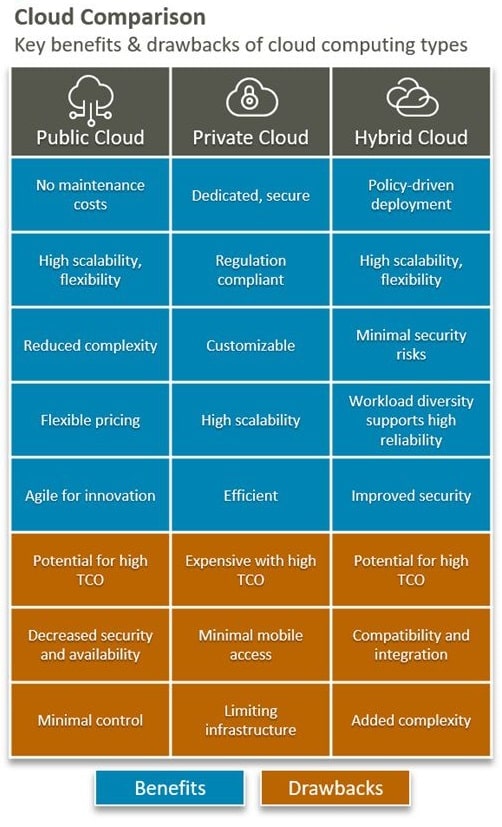
What is cloud computing?
Cloud computing processes or stores your programs, applications, and data over the Internet instead of directly on your computer’s hard drive. The most famous examples of cloud computing are Software as a Service (SaaS), Platform as a Service (PaaS), and Infrastructure as a Service (IaaS) – most of which you can choose to set up on a public or private platform. Cloud computing provides more services, including:
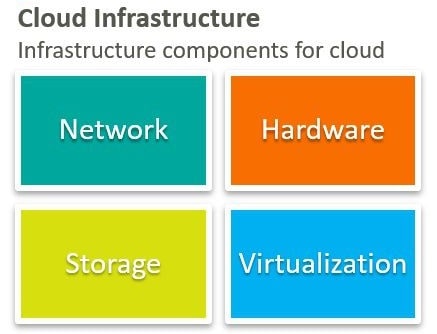
- AIaaS: Artificial Intelligence as a Service
- DaaS: Desktop as a Service
- ITaaS: Information Technology as a Service
- RaaS: Ransomware as a Service
Any cloud service consists of client-side systems or devices (PCs, tablets, etc.) connected to back-end data center components (servers). The elements that make up the cloud infrastructure are:
Basic infrastructure architecture can have various forms and features, including:
- Virtualized
- Software-defined
- Hyper-converged
Individuals and companies alike enjoy the distinct benefits of cloud computing, including:
- Reduce complexity
- DevOps optimization
- CapEx and OpEx exchanges
- Planning for the future
Examples and use cases of cloud computing
There are clear examples of cloud computing as well as use cases of public and private cloud differences that many of you may use in your personal or professional life:
- File sharing platforms, such as Dropbox, Google Docs, and Microsoft 365
- Social networks and telecommunication services such as Facebook, Twitter, and Skype
- CRMs and productivity management tools such as Salesforce and Atlassian
- ITSM and ITOM software such as BMC Helix
- Online streaming services such as Netflix, Sling, and Hulu
- Machine learning and extensive data analysis
- Internet of Things
What is a public cloud?
The public cloud refers to a cloud computing model in which IT services are provided over the Internet. As the most popular cloud computing service model known, the public cloud offers a wide selection of computing solutions and resources to meet the ever-increasing needs of organizations of all sizes.
The defining characteristics of a public cloud platform are:
- High flexibility and scalability
- Reasonable prices for plans
Public cloud services can be much cheaper than other services where you are charged based on the computing resources consumed.

Computing performance may range from standard services—email, applications, and file storage—to enterprise-level operating system platforms or infrastructure environments used for software development and testing, each of which has its differences and can be Public or private clouds provided.
A company that provides cloud services, whether public or private, is responsible for developing, managing, and maintaining a pool of computing resources shared among users across the network.
When to use the public cloud?
The public cloud is more suitable for these types of environments:
- Predictable computing needs, such as communication services for a certain number of users
- Programs and services necessary to carry out information technology and business operations
- Additional required resources to address various basic and urgent needs
- Software development and test environments
Benefits of public cloud
Some of the benefits of the public cloud are:
- No need for CapEx. There is no need to invest in IT infrastructure deployment and maintenance
- Technical agility. High scalability and flexibility to meet the requirements in an unpredictable work environment
- Business focus. Complexity is reduced, and requirements for IT expertise are minimized because the cloud service provider is responsible for managing the infrastructure.
- Increase financial power. Pricing options are flexible
- The cost agility of this service allows organizations to follow growth strategies and focus their investments on innovative projects.
Disadvantages of public cloud
The public cloud comes with limitations:
- Uncontrollable service total cost of ownership (TCO) can increase exponentially for large-scale deployments, especially for medium to large enterprises.
- The lack of security of the public cloud is inherently the least secure, so it’s not the best choice for mission-critical IT workloads.
- Minimal technical control and low infrastructure control may not meet your needs.
What is a private cloud?
Private cloud refers to any cloud solution that is dedicated for use by an organization. In the private cloud, unlike the public cloud, you don’t share cloud computing resources with any other organization, and this is the main difference.
Data center resources may be located at your location or operated by a third-party company overseas. Computing resources are isolated, delivered to you over a secure private network, and not shared with other customers.
A private cloud can customize to meet an organization’s unique business and security needs. With greater visibility and control over the infrastructure, organizations can run mission-critical computing without compromising the security and performance previously only available with dedicated on-premises data centers.
When to use a private cloud?
A private cloud is suitable for:
- Industries and government organizations with high supervision
- Sensitive data
- Companies that need robust control and security over their IT workloads and infrastructure
- Large companies that need advanced data center technologies for practical and cost-effective operation
- Organizations that can invest in high-performance and accessible technologies
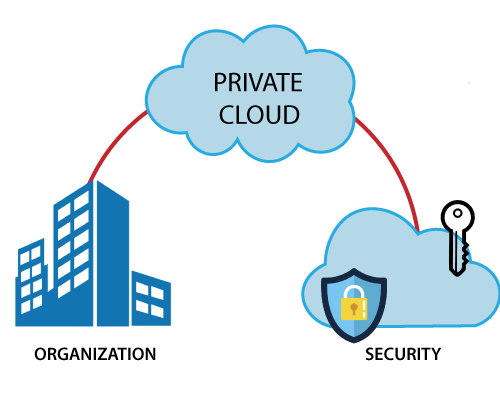
Advantages of private cloud
The most popular differences and advantages of a private cloud over a public cloud are:
- Exclusive environments are private and secure environments that are not accessible to other organizations.
- Customized security Comply with strict regulations because organizations can implement protocols, configurations, and actions to customize security based on their unique business requirements.
- High scalability and performance to meet unpredictable demands without compromising security and performance
- Efficient performance. The private cloud is reliable for high SLA performance and efficiency.
- Flexibility. The private cloud is flexible because you change the infrastructure based on the organization’s changing business and IT needs.
Disadvantages of private cloud
The private cloud has drawbacks that may limit its uses:
- high price Private cloud is an expensive solution with a relatively high TCO compared to public cloud alternatives, especially for short-term use cases.
- Mobile Difficulty Mobile users may have limited access to the private cloud due to high-security measures.
- Dependent scalability. The infrastructure may not provide high scalability to meet unpredictable needs if the cloud data center is limited to internal computing resources.
What is a hybrid cloud?
A hybrid cloud is any cloud infrastructure environment that combines public and private cloud platforms with minor differences. Resources are typically configured as an integrated infrastructure environment. Applications and data workloads can allocate resources between public and private cloud deployments based on corporate business and technical policies around aspects such as:
- security
- Performance
- Scalability
- Cost
- Efficiency
It is a typical example of a hybrid cloud: organizations can use private cloud environments for their IT workloads and supplement the infrastructure with public cloud resources to accommodate occasional spikes in network traffic.
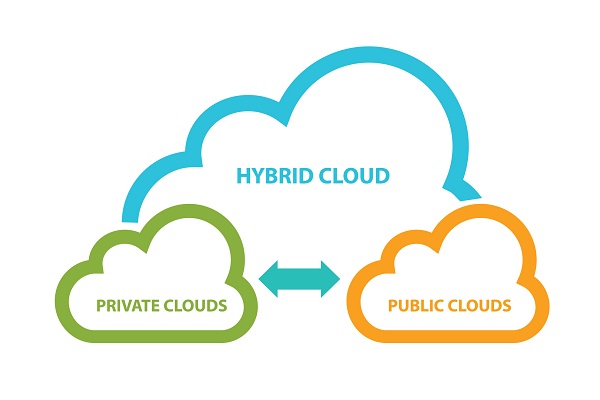
Or maybe they use the public cloud for workloads and data that are not sensitive and save money, but you choose the private cloud for sensitive data.
The domain is seamlessly integrated to ensure optimal performance and scalability for changing business needs. As a result, access to additional computing capacity does not require the high CapEx of a private cloud environment. Still, it is provided as a short-term IT service through a public cloud solution.
When you buy a hybrid cloud, you may need to decide whether it should be homogeneous or heterogeneous? Do you use cloud services from one vendor or several vendors?
When to use a hybrid cloud?
Here, the hybrid cloud is more suitable for the following people:
- Organizations that serve multiple verticals face different security, regulatory, and performance requirements
- Optimizing cloud investments without compromising the value that the difference between public and private cloud technologies can provide
- Improve security in existing cloud solutions such as SaaS offerings that must deliver over secure private networks
- A strategic approach to cloud investments is to shift continuously and trade between the best cloud service delivery models available in the market.
Advantages of hybrid cloud
- It is a Flexible policy-driven deployment for data distribution across public and private infrastructure environments based on security, performance, and cost.
- The scalability of public cloud environments is achieved without exposing critical IT workloads to inherent security risks.
- The distribution of services and data in several data centers, some public and some private, bring maximum reliability.
- Since sensitive data is stored on private clouds, cost control and improved security methods.
Disadvantages of hybrid cloud
Common drawbacks of hybrid cloud are:
- high price Tracking data movement between the public and private cloud can be strenuous and lead to unnecessary costs.
- Complex management. Strong compatibility and integration between cloud infrastructures spanning different locations and categories are required. It is a limitation of public cloud deployments, for which organizations do not have direct control over the infrastructure.
- When organizations manage a mix of private and public cloud architectures, additional infrastructure complexity is introduced.
Conclusion
Finally, it is essential to know that using any cloud environment will not eliminate your problems. Even though you are purchasing services from third-party vendors, you should still do your best to mitigate risk.

It is known as the cloud shared responsibility model. Although cloud service providers manage data and control things like flexibility and agility, your organization is responsible for:
- Who has access to what?
- Cloud security and encryption
- Planning for recovery problems
Which cloud should we choose?
Choosing between public, private, and hybrid cloud platforms depends on various factors such as use cases and constraints. In the real world, this is rarely a clear choice, especially since organizations tend to use all three types of cloud solutions for the inherent value propositions of each.
Although you probably already use the cloud, developing another cloud strategy is worth optimizing your use of any cloud environment. Start by defining different business needs, then prioritize them based on the pros and cons of each model. It is also necessary to compare cloud services with other services such as VPS to better understand the types of services in this field. You can refer to our cloud hosting and VPS comparison article.
It is known as the cloud shared responsibility model. Although cloud service providers manage data and control things like flexibility and agility, your organization is responsible for:
- Who has access to what?
- Cloud security and encryption
- Planning for recovery problems
Which cloud should we choose?
Choosing between public, private, and hybrid cloud platforms depends on various factors such as use cases and constraints. In the real world, this is rarely a clear choice, especially since organizations tend to use all three types of cloud solutions for the inherent value propositions of each.
Although you probably already use the cloud, developing another cloud strategy is worth optimizing your use of any cloud environment. Start by defining different business needs, then prioritize them based on the pros and cons of each model. It is also necessary to compare cloud services with other services such as VPS to better understand the types of services in this field. You can refer to our cloud hosting and VPS comparison article.
